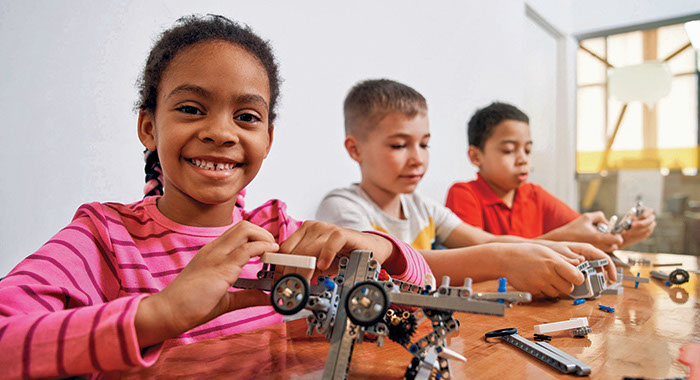What if you could help your child be more resilient, see failures as opportunities instead of stop signs, have a greater sense of self-confidence, and be a more curious, engaged learner? You can – by helping your child to develop a growth mindset rather than a fixed mindset!
People with a fixed mindset believe that their abilities are just that – fixed. To them, there is little point in working to improve their mental or physical abilities because they believe that their skills, talents and intelligence cannot change.
People with a growth mindset believe that their abilities can grow over time. They believe that applying effort and persistence can have a direct effect on their success. They are open to feedback because they believe they can improve by trying new methods, and they see mistakes as learning opportunities rather than signs of failure.
The brain works like a muscle
Start by talking to your child about the idea of a growth mindset versus a fixed mindset. The brain is made up of billions of neurons that transmit messages to each other. As we learn something new, the brain strengthens these connections between neurons. Practice and effort translate into stronger neural pathways that allow new skills to become easier to acquire over time. Teach your child that he can actually grow his brain by trying new things and not giving up when something is difficult. When children learn that the brain acts like a muscle that they can build and make stronger, they get excited to try and improve.
Model a growth mindset
One of the best ways to teach a growth mindset is to adopt one yourself. Our children are always observing us. Many of their attitudes, behaviors and ideas come from those demonstrated by the important adults in their lives.
When you face a challenge, narrate your thinking out loud so they can learn from your resilient attitude. You might say something like, “Wow! This is really difficult. I guess I need to keep practicing so I can improve.” Or you might comment, “Whew! This is really tricky. I’m going to take a short break and then try it a different way.” While it might be tempting to hide your mistakes from your children, by showing your struggles, you are demonstrating that challenges are just a part of life and not a reason to quit. Talk about what you’ve learned from your mistakes so you can model using them as a vehicle for growth and improvement.
Praise the process, not the product
“You are so smart!” and “Great job!” are examples of “product praise,” as they praise the outcome of the effort, not the effort itself. Product praise tends to come easiest to parents, but by using this type of praise, we can inadvertently send the message that the only important part of the experience is the final result. When a child needs to work harder at something to develop the skill, she may be more likely to give up if she isn’t achieving the end result that she wants.
By praising the process, children can feel proud of the progress they have made. You might say, “Wow! I see how hard you’ve been working to learn to tie your shoes and you have already figured out the first part. You’re really sticking with it and learning!” The key is to shift the focus to effort. For example, “Last year you couldn’t even dribble a basketball with your left hand, but since you’ve been practicing, you can almost dribble as well as you can with your right!”
Add “yet” to your vocabulary
Teach your child to use positive self-talk when getting discouraged. When faced with a challenge, one of the easiest ways to help your child switch out of a fixed mindset into a growth mindset is to add the word “yet.” It works especially well with sentences that include “can’t” or “don’t” because it reverses the negativity. For example, “I can’t do multiplication” becomes “I can’t do multiplication yet.” Just one little word changes the whole situation from one that feels hopeless to one that still holds possibility for growth.
Make a growth folder
Give your child a paper folder and let him draw a picture on the cover or write a short story that illustrates his idea of success. Every so often, add an example of success that came as a result of a growth mindset to the folder. It might be a good grade on a math test that was a result of hard work and studying, or it could be a drawing of learning to ride a bike. Periodically go through the folder together and relive the examples of growth. You can talk together about what helped your child to achieve each success. When school, extracurriculars or life in general feels hard, flip through the folder together to
help your child remember that times of growth and progress often come after struggles or challenges.
By teaching our children about the benefits of having a growth mindset, we will be helping them to be more confident, resilient and persistent. Rather than being a reason to give up, failure will simply become an invitation to keep trying, or to try a different strategy, until success is achieved. Not only will we be helping them in childhood, but these skills will be carried into adulthood and will serve them well in all aspects of life.
Alison Bogle is a writer living in Austin with her husband and three children. A former fourth-grade teacher, she now enjoys writing about children and education. You can also catch her talking about articles from Austin Family magazine each Thursday morning on FOX 7 Austin.














